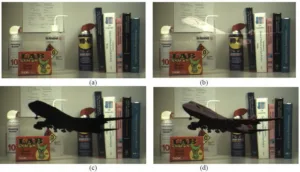This session, with four papers in it, was dedicated to advanced technology papers of interest to the AR/VR community but where the technologies are not ready to enter production now or, perhaps, ever. Three of these papers were optical designs for HMDs (46.1, 46.3, 46.4) while the fourth (46.2) was primarily a software paper.
Paper 46.1 was titled “Dual-layer High Dynamic Range Head Mounted Display” and was presented by Miaomiao Xu from the University of Arizona. The high dynamic range (HDR) was achieved by cascading two LCoS panels, separated by a relay lens. The size and weight of the two PBS elements plus the relay lens probably make this impractical for a HMD. I’ve seen projector designs work on this principle, however (and the new high contrast monitors shown at NAB use something similar – Man. Ed.)
Paper 46.3 was titled “High Contrast Ratio Electrochromic Light Shutter Device for Optical See-through Type Head Mounted Display” and was presented by Jin Hwan Park from Kyung Hee University in Seoul. Their system used a electrochromic device (ECD) to dim the see-through light in a AR HMD so the virtual image generated by the OLED microdisplay would be more visible. Clearly this is a possible, but not necessarily desirable, solution to AR contrast.
Paper 46.4 was titled “Perspective Correct Occlusion-Capable Augmented Reality Displays using Cloaking Optics Constraints” and was presented by Isela D. Howlett from Disney Research. This paper was rated a distinguished student paper and the extended version is available for free from the J-SID. This system was designed so that virtual objects could occlude real objects in the see-through image. This occlusion was done optically, not in software. Again, it’s a good idea but the relay lens needed probably makes it impractical for a see-through AR HMD.
 Left: a virtual object occluding a real scene. Right: The scene with no virtual object. (Image: Disney Research)
Left: a virtual object occluding a real scene. Right: The scene with no virtual object. (Image: Disney Research)
The software paper (46.2) was titled “Dynamic Real World Objects in Augmented and Virtual Reality Applications” was presented by Thomas Ebner from the Fraunhofer Heinrich Hertz Institute (HHI). This was also a distinguished paper. He described a system to rapidly acquire 3D models of moving objects, such as people. These 3D models could then be inserted into virtual worlds. (The HHI has done a lot of work on light field capture which would fit well with this work – Man. Ed.)

